In Search of Napoleon's Marshals
In the City of the Dead: Paris
by Patrick E. Wilson
| |
However, getting back to Paris in May 2001, I took the Paris metro to Pere Lachaise station and got off there, crossing the boulevard de Menilmontant and purchasing a plan of the cemetery from a local flower shop before entering Pere Lachaise via the Avenue de L'ouest. Heading off for the older part of the cemetery where according to the plan I had purchased, Ney's grave was to be seen. I noticed some other names that were familiar to me; the first I came across was a grave in the Avenue laterale Nord. It was weather beaten and looked somewhat abandoned, it was the grave of Marechal Emmanuel de Grouchy and his wife (see photograph PL1).
I felt saddened as I always considered Marechal Grouchy as being more able then some historians would have you believe, I thought he deserved better then this, although when the grave was erected in the 19th century it probably looked more impressive. However there is a fine view from the position of Grouchy's grave looking down toward the main (principal) avenue of Pere Lachaise, Grouchy though was not in a position to appreciate it.
I next came upon the family vault of Marechal Jacques MacDonald. It was another disappointment, an unimaginative structure which could have been dismissed as inconsequential if it wasn't for its noted occupant (see photograph PL4). MacDonald as we know was a bit unlucky, being beaten by both Survorov and Blucher, though winning undying fame at Wagram and fighting throughout 1813 and 1814 with vigour and honour.
Incidentally, Marechal Bessieres grave, according to the plan of La Pere Lachaise I was using should have been a little further north then Suchet's - between the Avenue Transversale 1 and Avenue Transversale 2 - but I could not locate it as the greenery made the area much darker and it was difficult to see particularly as I had no idea what the grave should look like.
Passing a grave with the bust of General Ruty, an artillery general at the Battle of Waterloo, I soon found myself next to the monument to Marechal Lefebvre and his equally famous wife Madame Sans Gene, I liked it. A traditional one, with a laurel wreath and Marechal Lefebvre's most famous victories inscribed on the stone work; Fleurus, Passage of the Rhine, Altenkirchen and Montmirail.
The next grave I sought was rather more difficult to find as it is not immediately seen from the avenue I was walking down, as it proved to be a low structure somewhat obscured by taller graves. Marechal Louis Davoust's (Davout) grave is indeed a low structure, understated and black with age. Not the sort of monument you would think such an illustrious figure would have had. But then Davoust died in the early 1820's when the royalists were in power and any show of due respect for such a figure from the Napoleonic past as Davoust would have been frowned upon by the Ultras.
Davoust's family was also short of money and this may have contributed to the simple monument or could it be, given the nature of the Marechal, that such a monument was in keeping with his wishes (see photograph PL9).
Situated in a corner of the graveyard to the south-east of Davoust's it is quite impressive. The grave itself is surrounded by a wall on three sides, on this wall there is inscribed a brief history of the Marechal and a bust of him is built into the central part of the well. The bust or rather half bust is in white stone so that it is highlighted and draws the attention of the visitor, the fourth side of the grave, the open part, is chained off but allows the visitor to read the inscriptions on three sided wall that makes up the rest of the grave. The grave was also decorated with some flowers when I was there unlike most of the other graves I had visited. So it would seem that Marechal Ney is not forgotten even today. I was quite content with the grave and thought it was a fitting one for Ney. (see Photographs PL11 and P1.12).
Apparently there are other marechals buried in Pere Lachaise, although I didn't visit them as I did not then know they were there. Marechal Pierre Augereau is buried on the Avenue Circulaire, which is below Grouchy's grave so that if you just followed the Avenue Laterale Nord down the bank (and it is down hill, a fairly steep one too!), the avenue that cuts across at the bottom is the Avenue Circulaire, turn right and Augereau's grave should be along that way. Another Marechal is Dominique Perignon, who is just off the Avenue Transversale 1 and on a corner (like Ney) opposite Gros, a Napoleonic painter (a pupil of David I think). This grave in turn is not far from that of General Junot (who should have been made a Marechal) and Sir Sidney Smith, a pain in the neck of Napoleon.
Near Perignon too is a grave for Charles Oudinot though this is not the Marechal but his son. Marechal Oudinot like Marechal Moncey is buried in the Aisle of the brave in the church at Les Invalides, I saw the monuments to them when I visited Les Invalides a couple of days later. The Aisle of the brave is in church next door to Napoleon's
impressive, not to say absolutely magnificent tomb, I have never seen anything so awe inspiring! Marechal Moncey's monument or should I say plaque is on the right of the Aisle, Oudinot's on the left opposite each other. (It was a church so I did not take any pictures).
Finally I am sure that I have read somewhere that Marechal Jean-Baptiste Jourdan is also buried at La Pere Lachaise but the plan I have doesn't show where, if so I think it would be somewhere near the majority of the others in the north-east part of Pere Lachaise. There is another grave or rather crypt that I visited whilst in Paris.
The Pantheon is a church/temple in central Paris, not far from Notre Dame, containing the mortal remains of the heroes of France. It holds Voltaire, Rousseau and a host of other eminent figures besides a number of Napoleonic soldiers. Foremost amongst these is Marechal Lannes, others include General Jean Louis Reynier, General
Jean Marie Dorsenne (of the French Imperial Guard) and General Louis de St.Hilaire. The majority of these figures are interned in the vaults, many having to share, there is room for four in each vault although Lannes, like the "organiser of victory" Lazare Carnot, has a vault to himself. It is impressive, a large coffin surrounded by the tricolour
and fresh flowers, and a large portrait of the Lannes by Gerard. It is like he died only yesterday and leads one to believe that Lannes is still something of a hero even today. I saw a new biography of him in several of the museums I visited and his uniforms were on display at Les Invalides, including the one he worn in the portrait by Gerard. The uniforms looked almost new but he must have been a chap of slight build as they seemed small to me! Lannes tomb (see photograph PL13) is therefore worth a visit, especially as you get to see Voltaire's, Rousseau's and Carnot's too.
On a final note, I also visited Ney's statue in central Paris see photograph's PL14 & P1.15, It is situated not far from the Luxemberg gardens, where as we all know he was shot (a pleasant enough park to take a Sunday morning stroll in, as I did), at the junction of the Boulevard Saint Michel and Montparnasse, on the Place Camille Julian. It is also somewhat hidden by the trees but on the bright spring morning I saw it, well worth the effort to find it. Ney's statue has its arm raised as if leading forward his men and is on a plinth that has been inscribed with all Ney's battles and actions, a really fine statue but then I am biased!
|
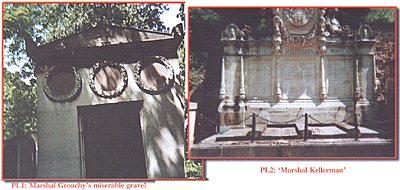 On a sunny day last year I visited La Pere Lachaise cemetery in Paris in search of Marechal Ney's grave, which as an avid fan of that particular Napoleonic soldier I knew to be in that cemetery. Although according to the American writer Leggett Blythe, author of Marshal Ney: A Dual Life. Which argues that Ney is actually buried in South Carolina in the grave of a schoolteacher known as Peter Stewart Ney whilst a corpse from a local mortuary actually occupies Ney's grave in Paris. I find this doubtful but Mr Blythe argues his story well and if one is prepared to believe that Ney's execution was stage-managed, his Masonic friends spiriting him away to America to begin a new life as a teacher of Mathematics in South Carolina. Such is the story and well worth a read if you can find a copy, I know I enjoyed reading it immensely.
On a sunny day last year I visited La Pere Lachaise cemetery in Paris in search of Marechal Ney's grave, which as an avid fan of that particular Napoleonic soldier I knew to be in that cemetery. Although according to the American writer Leggett Blythe, author of Marshal Ney: A Dual Life. Which argues that Ney is actually buried in South Carolina in the grave of a schoolteacher known as Peter Stewart Ney whilst a corpse from a local mortuary actually occupies Ney's grave in Paris. I find this doubtful but Mr Blythe argues his story well and if one is prepared to believe that Ney's execution was stage-managed, his Masonic friends spiriting him away to America to begin a new life as a teacher of Mathematics in South Carolina. Such is the story and well worth a read if you can find a copy, I know I enjoyed reading it immensely.
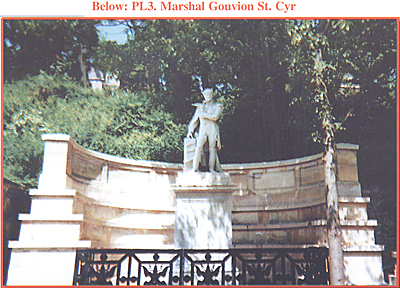 I then headed for the Avenue des Acacias and the next historical name I could find, Kellermann. This grave was more like it, a substantial family monument containing not only Marechal Kellermann but his more famous son too, the cavalryman who led his cavalry to fame at the battles of Marengo and Quatre Bras. It was magnificent I thought standing there in the sunshine and surrounded by the greenery of the Avenue des Acacias (see photograph PL2). Five minutes later I came upon the grave of Marechal Laurent Gouvion St Cyr, a Marshal not that well known but who was by all accounts a excellent defensive general. He made his name at the Battles of Biberach, Polotsk and Dresden. The grave itself was in the form of a half circle, a sort of half classical arena with St. Cyr's remains in the centre surmounted by a fine statue of the general at the height of his powers - well worth a visit! (See photograph PL3).
I then headed for the Avenue des Acacias and the next historical name I could find, Kellermann. This grave was more like it, a substantial family monument containing not only Marechal Kellermann but his more famous son too, the cavalryman who led his cavalry to fame at the battles of Marengo and Quatre Bras. It was magnificent I thought standing there in the sunshine and surrounded by the greenery of the Avenue des Acacias (see photograph PL2). Five minutes later I came upon the grave of Marechal Laurent Gouvion St Cyr, a Marshal not that well known but who was by all accounts a excellent defensive general. He made his name at the Battles of Biberach, Polotsk and Dresden. The grave itself was in the form of a half circle, a sort of half classical arena with St. Cyr's remains in the centre surmounted by a fine statue of the general at the height of his powers - well worth a visit! (See photograph PL3).
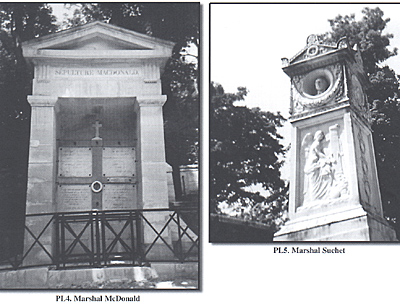 In a smaller avenue a little to the west of the Avenue des Acacias I came across some of the more famous of Napoleon's Marshals. The first, more to the north then the rest, was a monument to Marechal Louis Gabriel Suchet, one of the few French generals who did well in Spain. It was in the form of a column with a bust of the marshal towards the top of the monument, it was a good likeness and of a pleasant white stone, another must see (photogragh PL5).
In a smaller avenue a little to the west of the Avenue des Acacias I came across some of the more famous of Napoleon's Marshals. The first, more to the north then the rest, was a monument to Marechal Louis Gabriel Suchet, one of the few French generals who did well in Spain. It was in the form of a column with a bust of the marshal towards the top of the monument, it was a good likeness and of a pleasant white stone, another must see (photogragh PL5).
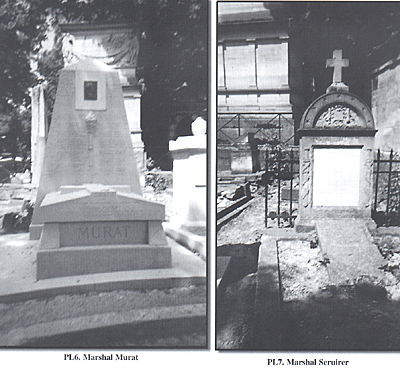 After Suchet, I arrived before the monument to Marechal Joachim Murat and his family, I trust I need not say anything about this French general. The monument was much smaller then say that of Kellermann or St. Cyr but pleasant enough with its small image of the Marechal in a different colour stone to the rest of the grave. Another interesting element is that the monument listed all the other family members too, telling us that Caroline Bonaparte rests there also (see photograph PL6). Right next to this grave lies another that of Marechal Philbert Serurier, Napoleon's Governor of Les Invalides and a veteran of the French Revolutionary Wars. Serurier served throughout Napoleon's first Italian campaign, and was the man responsible for the destruction of Frederick the Great's sword and over 1,400 captured enemy colours as the Allied armies approached Paris in 1814. Sadly the grave was in the same state as Marechal Grouchy's, a lot smaller and only the Marshal's stars on the stone work told the observer of the importance of the grave's occupant, which is just as well as the lettering, like that of Grouchy's, was difficult to read (see photograph PL7). Serurier
I felt derserved better.
After Suchet, I arrived before the monument to Marechal Joachim Murat and his family, I trust I need not say anything about this French general. The monument was much smaller then say that of Kellermann or St. Cyr but pleasant enough with its small image of the Marechal in a different colour stone to the rest of the grave. Another interesting element is that the monument listed all the other family members too, telling us that Caroline Bonaparte rests there also (see photograph PL6). Right next to this grave lies another that of Marechal Philbert Serurier, Napoleon's Governor of Les Invalides and a veteran of the French Revolutionary Wars. Serurier served throughout Napoleon's first Italian campaign, and was the man responsible for the destruction of Frederick the Great's sword and over 1,400 captured enemy colours as the Allied armies approached Paris in 1814. Sadly the grave was in the same state as Marechal Grouchy's, a lot smaller and only the Marshal's stars on the stone work told the observer of the importance of the grave's occupant, which is just as well as the lettering, like that of Grouchy's, was difficult to read (see photograph PL7). Serurier
I felt derserved better.
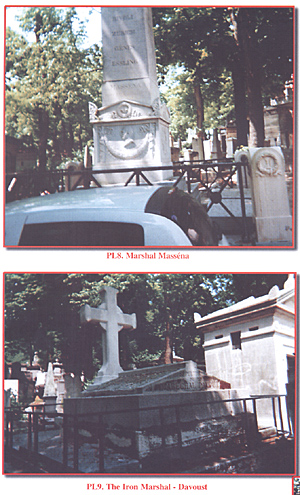 Right next to Lefebvre's monument stood that of Marechal Andre Massena, perhaps the greatest of all Napoleon's generals. Massena as most of us know was of Italian stock and that is where he first rose to prominence like Napoleon. Massena's grave bears the names of his greatest victories/achievements; Rivoli, Zurich, Genoa and Essling and the simple inscription "Massena" for at the time of his death everyone knew who "Massena" was. Today it may not be so. The grave is surmounted by a column, rather Egyptian in style, bearing the names of his victories and is quite striking, in sharp contrast to Lefebvre's monument but I think eminently suitable for the general who sleeps beneath it (see photograph PL8). (The car parked beside the grave, I think, does not belong to Massena, though given his miserly reputation could well have been the type of car he would have owned!).
Right next to Lefebvre's monument stood that of Marechal Andre Massena, perhaps the greatest of all Napoleon's generals. Massena as most of us know was of Italian stock and that is where he first rose to prominence like Napoleon. Massena's grave bears the names of his greatest victories/achievements; Rivoli, Zurich, Genoa and Essling and the simple inscription "Massena" for at the time of his death everyone knew who "Massena" was. Today it may not be so. The grave is surmounted by a column, rather Egyptian in style, bearing the names of his victories and is quite striking, in sharp contrast to Lefebvre's monument but I think eminently suitable for the general who sleeps beneath it (see photograph PL8). (The car parked beside the grave, I think, does not belong to Massena, though given his miserly reputation could well have been the type of car he would have owned!).
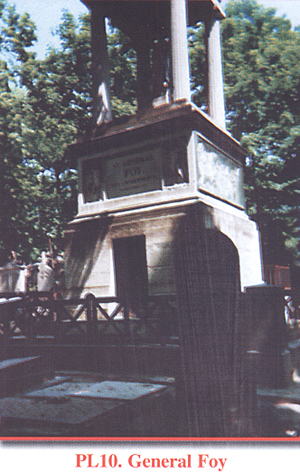 We have only to contrast Davoust's monument with that of General Foy's who died a few years later to glimpse the shift in politics. Foy was a republican, a known and valued soldier and politician whose monument was funded by donations from the general public amid genuine widespread sorrow. His grave is very impressive. "It is as big a small house", remarked my girlfriend and so it is! A monument fit for a Marechal at least! Though General Foy was a very experienced soldier having fought for Napoleon in many of his campaigns and battles; Austerlitz, Friedland, Bussaco, Fuentes de Onoro, Salamanca, Waterloo and many others and probably deserved a Marechal's baton, which is more then can be said for certain Marechals. Still, Foy's monument, is one of the most impressive to be seen in the whole of La Pere Lachaise (see photograph PL10). Foy's grave is also beyond the grave I was next to see, the grave for which I had made the whole journey to La Pere Lachaise.
We have only to contrast Davoust's monument with that of General Foy's who died a few years later to glimpse the shift in politics. Foy was a republican, a known and valued soldier and politician whose monument was funded by donations from the general public amid genuine widespread sorrow. His grave is very impressive. "It is as big a small house", remarked my girlfriend and so it is! A monument fit for a Marechal at least! Though General Foy was a very experienced soldier having fought for Napoleon in many of his campaigns and battles; Austerlitz, Friedland, Bussaco, Fuentes de Onoro, Salamanca, Waterloo and many others and probably deserved a Marechal's baton, which is more then can be said for certain Marechals. Still, Foy's monument, is one of the most impressive to be seen in the whole of La Pere Lachaise (see photograph PL10). Foy's grave is also beyond the grave I was next to see, the grave for which I had made the whole journey to La Pere Lachaise.
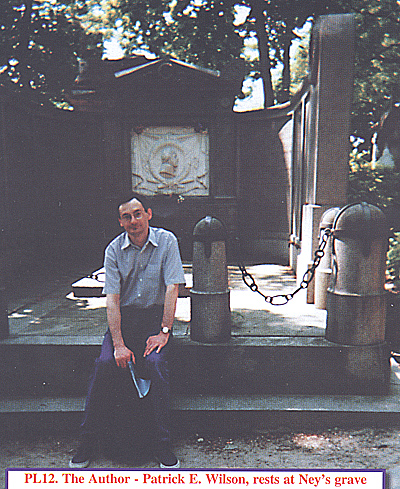 The Grave of Marechal Ney
The Grave of Marechal Ney
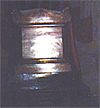 This is the tomb of Marechal Jean Lannes, Napoleon's best friend, which is in the Pantheon.
This is the tomb of Marechal Jean Lannes, Napoleon's best friend, which is in the Pantheon.